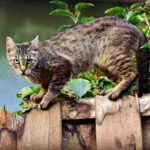Essential oils can be harmful to cats due to their unique physiology, but with the right knowledge, you can create a safe and healthy environment for your feline friend, and solcat.net is here to help you navigate the world of cat care. This article will guide you through identifying which essential oils pose a risk to your cat’s health and how to use them safely. Understanding these risks is crucial for responsible pet ownership and ensuring your cat’s well-being. Dive into solcat.net for more insightful resources on cat health and safety.
1. Why Are Essential Oils Harmful to Cats?
Essential oils can be toxic to cats because of how cats metabolize these substances. Cats lack specific liver enzymes necessary to break down the compounds found in essential oils effectively, according to the American Animal Hospital Association (AAHA). This deficiency leads to a buildup of toxins in their system, posing significant health risks.
- Metabolic Differences: Cats’ livers don’t process phenols and other compounds in essential oils as efficiently as other animals.
- Rapid Absorption: Essential oils are quickly absorbed orally and through the skin, escalating the risk of toxicity.
- Concentration Matters: The higher the concentration of the essential oil, the greater the danger to your cat.
2. Which Essential Oils Should I Avoid Using Around Cats?
Certain essential oils are particularly dangerous for cats and should be avoided. Understanding which oils pose a risk can help you create a safe environment for your feline companion.
Here’s a list of essential oils known to be toxic to cats:
| Essential Oil | Potential Symptoms |
|---|---|
| Oil of Wintergreen | Vomiting, diarrhea, lethargy, incoordination, and in severe cases, seizures or liver failure. |
| Oil of Sweet Birch | Similar to wintergreen; causes gastrointestinal upset, neurological issues, and liver damage. |
| Citrus Oil (d-limonene) | Skin irritation, drooling, tremors, and potentially liver damage. |
| Pine Oil | Irritation to the skin and mucous membranes, drooling, vomiting, weakness, and neurological symptoms. |
| Ylang Ylang Oil | Respiratory distress, incoordination, weakness, and potential allergic reactions. |
| Peppermint Oil | Drooling, vomiting, diarrhea, and in high concentrations, neurological symptoms. |
| Cinnamon Oil | Irritation to the mouth and skin, vomiting, diarrhea, and potential liver damage. |
| Pennyroyal Oil | Liver failure, seizures, and potentially death, even in small amounts. |
| Clove Oil | Irritation to the mouth and skin, vomiting, tremors, and liver damage. |
| Eucalyptus Oil | Drooling, vomiting, diarrhea, weakness, and in severe cases, seizures. |
| Tea Tree Oil (Melaleuca) | Neurological symptoms such as tremors, incoordination, and seizures; also causes skin irritation and gastrointestinal upset. According to a study by the ASPCA, tea tree oil is one of the most common essential oils causing toxicity in pets. |
 Essential Oils
Essential Oils
3. What Symptoms Indicate Essential Oil Poisoning in Cats?
Recognizing the signs of essential oil poisoning in cats is crucial for prompt treatment. If you suspect your cat has been exposed to a toxic essential oil, immediate veterinary attention can be life-saving.
Common symptoms include:
- Drooling: Excessive salivation is often one of the first signs.
- Vomiting: Your cat may vomit in an attempt to rid its body of the toxin.
- Tremors: Muscle tremors or shaking can indicate neurological involvement.
- Ataxia (Wobbliness): Loss of coordination or unsteady gait.
- Respiratory Distress: Difficulty breathing, rapid breathing, or wheezing.
- Low Heart Rate: A slower than normal heart rate.
- Low Body Temperature: A drop in body temperature below the normal range.
- Liver Failure: Jaundice (yellowing of the skin and eyes), loss of appetite, and abdominal pain.
If your cat exhibits any of these symptoms, contact your veterinarian or an animal poison control center immediately. Early intervention can significantly improve the outcome.
4. How Do Essential Oil Diffusers Affect Cats?
Essential oil diffusers can pose a risk to cats, depending on the type and how they are used. Understanding these risks can help you make informed decisions about using diffusers in your home.
4.1. Passive Diffusers
Passive diffusers release essential oils into the air through evaporation. Types include reed diffusers, heat diffusers, and personal evaporative diffusers.
- Reed Diffusers: Reeds soak up the oil and disperse it into the air.
- Heat Diffusers: Electric or candle-based warmers evaporate the oil.
- Personal Evaporative Diffusers: Pendants or bracelets use air currents to diffuse the aroma.
The main risk from passive diffusers is respiratory irritation. Strong odors can cause watery eyes, a burning sensation in the nose and throat, nausea, drooling, vomiting, and difficulty breathing. Cats with pre-existing respiratory issues, such as asthma or allergies, are more susceptible.
4.2. Active Diffusers
Active diffusers emit microdroplets of oil into the air. Nebulizing diffusers and ultrasonic diffusers fall into this category.
- Nebulizing Diffusers: Use a high-speed air stream and an atomizing nozzle.
- Ultrasonic Diffusers: Use electric current to emit a vibration.
These diffusers pose a greater risk because the microdroplets can settle on a cat’s fur, leading to absorption through the skin or ingestion during grooming. This can result in drooling, vomiting, tremors, ataxia, respiratory distress, low heart rate, low body temperature, and liver failure.
 Essential Oil Diffuser
Essential Oil Diffuser
5. How Can I Safely Use Essential Oils Around Cats?
If you choose to use essential oils, taking precautions can minimize the risks to your cat. Safe usage involves careful selection, dilution, and placement of the oils.
- Choose Cat-Safe Oils: Opt for essential oils known to be safe for cats in very diluted forms, such as chamomile or lavender, and only after consulting with a veterinarian.
- Dilute Properly: Always dilute essential oils significantly before use.
- Use Passive Diffusers: If using a diffuser, choose passive options that don’t emit microdroplets.
- Ensure Ventilation: Use diffusers in well-ventilated areas to prevent concentration buildup.
- Limit Exposure: Keep the duration of diffusion short and infrequent.
- Monitor Your Cat: Watch for any signs of discomfort or adverse reactions.
- Store Safely: Keep essential oils out of reach of cats to prevent accidental ingestion.
- Consult Your Veterinarian: Before using any essential oils around your cat, consult with your veterinarian for personalized advice.
6. What Should I Do if My Cat Is Exposed to a Toxic Essential Oil?
If your cat is exposed to a toxic essential oil, quick action is essential. The steps you take immediately can significantly impact the outcome.
- Remove the Source: Immediately remove the essential oil or diffuser from the cat’s environment.
- Assess Symptoms: Check for any signs of poisoning, such as drooling, vomiting, tremors, or respiratory distress.
- Clean the Cat: If the oil has come into contact with your cat’s skin or fur, wash the affected area with mild dish soap and water.
- Seek Veterinary Advice: Contact your veterinarian or an animal poison control center immediately. Be prepared to provide information about the type of oil, the amount of exposure, and your cat’s symptoms.
- Follow Veterinary Instructions: Follow the veterinarian’s instructions carefully. Do not attempt to treat your cat at home without professional guidance.
7. Are There Any Safe Alternatives to Essential Oils for Cats?
If you’re concerned about the risks of essential oils, there are safer alternatives for creating a pleasant environment for your cat.
7.1. Cat-Friendly Scents
Cats have different scent preferences than humans. Instead of trying to create a human-pleasing aroma, consider using scents that cats enjoy.
- Catnip: Known for its euphoric effects on cats.
- Silvervine: A plant similar to catnip that many cats respond to.
- Honeysuckle: Some cats enjoy the scent of honeysuckle.
7.2. Synthetic Pheromone Diffusers
Synthetic pheromone diffusers mimic natural feline pheromones, which can help reduce stress and anxiety in cats. These diffusers release a calming scent that is undetectable to humans but can have a positive effect on cats.
7.3. Natural Air Purifiers
Instead of using scents to improve the air quality in your home, consider using natural air purifiers.
- Houseplants: Certain houseplants, such as spider plants and snake plants, can help filter toxins from the air.
- Air Purifiers: Electronic air purifiers with HEPA filters can remove allergens and pollutants from the air.
8. What Do Experts Say About Essential Oils and Cats?
Experts in veterinary medicine and toxicology emphasize the risks of using essential oils around cats. Consulting reliable sources can provide valuable insights.
8.1. Cornell Feline Health Center
The Cornell Feline Health Center advises caution when using essential oils around cats, highlighting the lack of necessary liver enzymes to metabolize these substances safely.
8.2. American Animal Hospital Association (AAHA)
AAHA recommends avoiding the use of essential oils around pets due to the potential for toxicity and respiratory irritation.
8.3. Veterinarians and Toxicologists
Veterinarians and toxicologists often caution against the use of essential oils around cats, citing cases of poisoning and adverse reactions. They recommend consulting with a veterinarian before using any essential oils in a home with cats.
9. Understanding the Science Behind Essential Oil Toxicity in Cats
Delving into the scientific aspects of why essential oils are toxic to cats provides a deeper understanding of the risks involved. This knowledge can empower you to make informed decisions about your cat’s health and safety.
9.1. Liver Metabolism
Cats lack specific liver enzymes, particularly glucuronyl transferases, which are essential for metabolizing certain compounds found in essential oils. This deficiency leads to a buildup of toxins in their system, causing liver damage and other health problems.
9.2. Phenols and Phenolic Compounds
Essential oils contain phenols and phenolic compounds, which are particularly toxic to cats. These substances are rapidly absorbed and can cause severe irritation and damage to the liver and nervous system.
9.3. Respiratory Irritation
The inhalation of essential oil vapors can cause respiratory irritation in cats. The delicate respiratory system of cats is highly sensitive to strong odors and chemicals, leading to inflammation and breathing difficulties.
10. How To Create a Cat-Friendly Home Environment
Creating a cat-friendly home environment involves more than just avoiding toxic substances. It also includes providing enrichment, comfort, and security for your feline companion.
10.1. Provide Enrichment
Cats need mental and physical stimulation to stay happy and healthy. Provide a variety of toys, scratching posts, and climbing structures to keep your cat entertained.
10.2. Create Safe Spaces
Cats need safe spaces where they can retreat and feel secure. Provide comfortable beds, cat trees, and quiet areas where your cat can relax undisturbed.
10.3. Maintain a Clean Environment
A clean environment is essential for your cat’s health. Regularly clean litter boxes, food and water bowls, and living areas to prevent the spread of disease.
10.4. Use Cat-Friendly Cleaning Products
Many household cleaning products contain chemicals that are toxic to cats. Opt for cat-friendly cleaning products that are safe for use around pets.
By creating a safe, stimulating, and comfortable environment, you can enhance your cat’s quality of life and strengthen your bond.
Navigating the world of essential oils and cat safety can be complex, but solcat.net is here to provide the information and resources you need.
Address: 950 Alaskan Way, Seattle, WA 98104, United States
Phone: +1 (206) 386-4000
Website: solcat.net
FAQ: Essential Oils and Cat Safety
1. Are all essential oils bad for cats?
Not all essential oils are inherently bad for cats, but many pose significant risks due to cats’ unique physiology. Some oils are more toxic than others, and the level of risk depends on factors like concentration, method of use, and the cat’s individual health. Always consult with a veterinarian before using any essential oils around your cat.
2. Can I use a diffuser if my cat is in a different room?
Even if your cat is in a different room, using a diffuser can still pose risks. The microdroplets emitted by active diffusers can travel through the air and settle on surfaces in other rooms, potentially exposing your cat. It’s best to avoid using diffusers altogether or ensure they are used in well-ventilated areas that your cat cannot access.
3. What should I do if my cat licks essential oil?
If your cat licks essential oil, it’s crucial to act quickly. First, try to rinse your cat’s mouth with water to remove any remaining oil. Then, contact your veterinarian or an animal poison control center immediately for further guidance. Be prepared to provide information about the type of oil, the amount ingested, and any symptoms your cat is exhibiting.
4. Are hydrosols safer than essential oils for cats?
Hydrosols, also known as floral waters, are the byproduct of essential oil distillation. They are much less concentrated than essential oils and are generally considered safer for use around cats. However, it’s still important to exercise caution and consult with a veterinarian before using hydrosols, as some cats may still be sensitive to them.
5. Can I use essential oil-based cleaning products if I have a cat?
Using essential oil-based cleaning products can be risky if you have a cat. Many essential oils are toxic to cats and can cause adverse reactions if ingested or absorbed through the skin. Opt for cat-friendly cleaning products that are specifically formulated to be safe for use around pets.
6. What are the long-term effects of essential oil exposure in cats?
Long-term exposure to essential oils can have serious health consequences for cats. Chronic exposure can lead to liver damage, respiratory problems, neurological issues, and other health complications. It’s important to minimize your cat’s exposure to essential oils and seek veterinary attention if you suspect any adverse effects.
7. How can I tell if an essential oil is safe for my cat?
The safest approach is to avoid using essential oils altogether or to consult with a veterinarian before using any essential oils around your cat. If you choose to use essential oils, research each oil thoroughly and select those that are known to be safe for cats in very diluted forms. Always monitor your cat for any signs of discomfort or adverse reactions.
8. Are there any essential oils that are beneficial for cats?
While many essential oils are harmful to cats, some may offer potential benefits when used appropriately and under veterinary supervision. For example, chamomile and lavender may help reduce stress and anxiety in some cats. However, it’s crucial to use these oils in very diluted forms and to monitor your cat closely for any adverse reactions.
9. Can I put essential oils on my cat’s collar to prevent fleas?
Using essential oils on your cat’s collar to prevent fleas is not recommended. Many essential oils are toxic to cats and can cause skin irritation, respiratory problems, and other health issues. Opt for veterinarian-approved flea prevention products that are safe and effective for cats.
10. How can I create a safe and pleasant-smelling home environment for my cat without using essential oils?
Creating a safe and pleasant-smelling home environment for your cat without using essential oils is entirely possible. Consider using cat-friendly scents like catnip or silvervine, synthetic pheromone diffusers to reduce stress, and natural air purifiers like houseplants to improve air quality. Regularly cleaning your home and using cat-friendly cleaning products can also help maintain a fresh and healthy environment for your feline companion.
Remember to visit solcat.net for more information and resources on cat care!
Conclusion: Prioritizing Your Cat’s Safety
When it comes to essential oils and cats, caution is key. Many essential oils pose significant risks to cats due to their unique physiology and sensitivity to certain compounds. By understanding which oils to avoid, how diffusers can be harmful, and what symptoms to watch for, you can protect your feline friend from potential harm.
If you choose to use essential oils, do so with care and always consult with a veterinarian for personalized advice. Remember that there are safer alternatives for creating a pleasant environment for your cat, such as cat-friendly scents, synthetic pheromone diffusers, and natural air purifiers.
At solcat.net, we are committed to providing you with the information and resources you need to ensure your cat’s health and well-being. Explore our website for more articles, guides, and expert advice on all aspects of cat care. Together, we can create a safe, happy, and thriving environment for our feline companions.
Visit solcat.net today to discover more ways to enhance your cat’s life!


